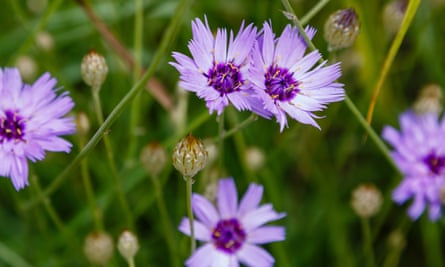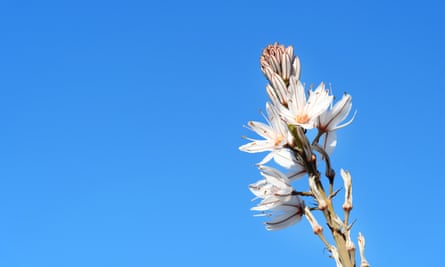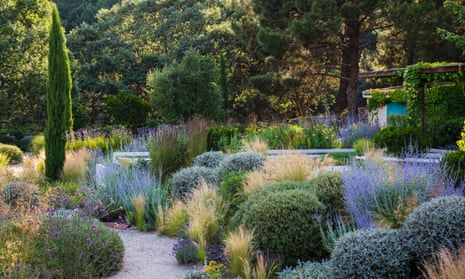This spring, I spent a month exploring Spain, driving from lush northern Cantabria down to Andalucia and back through the dry central plateaux surrounding Madrid. Foremost a family holiday, the secondary motivation was horticultural: to find inspiration in one of the countries that gave our gardens the drought-tolerant staples of lavender, tree germander and Euphorbia characias.
With increasing weather extremes (the UK and the world recently registered their hottest June ever), many gardeners have been reconsidering some of their traditional, water-thirsty cottage garden varieties in favour of plants better able to cope with these challenging conditions.
At the Garden Museum in London last summer, I watched herbaceous border regulars such as bistort, geranium and Michaelmas daisy crisp under 40-degree heat, while the plants in our unwatered, shingle-mulched beds – Mediterranean faithfuls including helichrysum, rosemary and ballota – remained radiant.
But if we are to avoid becoming a nation of lavender addicts, we should broaden the range of plants we grow, not least to support the widest possible biodiversity in our gardens. While American prairie plants can thrive in gardens with more water-retentive, clay soils, even these will struggle in periods of drought. Spain’s native flora are brilliantly adapted to hot, dry conditions – bold, colourful and resilient Mediterranean species well suited to many UK gardens. Here are the species I plan to plant back home. Whether grown in the ground or in containers, all are best suited to a free-draining soil and a sunny, south- or west-facing position.
Mastic (Pistacia lentiscus)

A spectacular mountainous drive between Toledo and the central province of Ávila, followed by an unnervingly steep track along lupin-strewn olive groves, brought me to the home of Spanish garden designer Álvaro Sampedro. A plantsman in the vanguard of progressive, native planting, Sampedro’s own garden features pockets of exuberant planting trialled for low irrigation, colour and companion combinations. Among the structural shrubs was the wild mastic, Pistacia lentiscus – an aromatic leaved, red-fruited Mediterranean bush. “It’s a tough evergreen that grows near the sea and seems to cope however hot it gets.” Mastic featured at Chelsea flower show this year and will no doubt prove increasingly capable of overwintering on free-draining and coastal UK soils. Its olive-green foliage makes it the ideal foil for bright flowers such as verbascum or sea holly (from burncoose.co.uk).
Pink rockrose (Cistus x skanbergii)
Sampedro employs tough yet decorative shrubs such as the compact Cistus x skanbergii, which has early, pale rose blooms, silver-green foliage and is easy to maintain. “It mixes very well with all perennials, and if you prune it back after blooming you can have repeat flowers,” he said. This cistus is a fantastic small shrub for repeating through a mixed, sunny border (bethchatto.co.uk).
Tree heather (Erica arborea)
The most compelling of all Sampedro’s plants, an erect tree heather that occurs naturally in the surrounding forests. Its maroon-centred white flowers prefer neutral to acidic soils, while the hardier, pink-tipped Erica x darleyensis cultivars that Sampedro also grows will survive cooler British winter temperatures (theheathergarden.co.uk).
Giant fennel (Ferula tingitana ‘Cedric Morris’)
Flowers were the focus farther south in Andalucía, when we stayed at Finca las Morenas, the guesthouse of garden designers Mhairi and Simon Clutson. Having specialised in Mediterranean-style garden design in London for 20 years, the Clutsons moved to this Málaga hillside in 2016, where they continue their business from their unirrigated, sustainably managed garden. When we visited in late April, you couldn’t miss the towering pompon fennels mounted above the driveway – the giant Ferula tingitana ‘Cedric Morris’, named after the artist-plantsman who collected and cultivated them in Suffolk. Remarkably hardy, these glossy-leaved, self-seeding biennials are easy to grow, forming mounds of feathery foliage in the first year or two and multi-headed stems the next (shop.greatdixter.co.uk).
Blue rock bindweed (Convolvulus sabatius)

On a smaller scale to the fennel yet no less prolific was Convolvulus sabatius, a stunning member of the bindweed genus that, unlike its notorious cousins, gently trails rather than smothers. Formerly restricted to the summer hanging basket, vivid blue-purple sabatius now overwinters in parts of the UK, and makes an excellent ground-cover perennial (pottertons.co.uk).
Cupid’s dart (Catananche caerulea)

Another magnificent local purple was that of the densely flowering, daisy-like Catananche caerulea, known as cupid’s dart; a summer favourite of Mhairi’s. “It’s reliable, hardy, long-flowering and produces masses of seed – an easy perennial for gardens with good drainage.” Catananche also make excellent biennial or short-lived perennials for pots and are brilliant at attracting pollinators (crocus.co.uk).
after newsletter promotion
White asphodel

Throughout the trip, my notebook filled with mentions of memorable plants in memorable places: the meadows of clover-red sweetvetch outside Cádiz; the burgundy-tipped fumitory that festooned Santillana del Mar’s ancient walls. Excitement always soared, however, at the sight of Mediterranean asphodels in bloom, in particular the prominent white Asphodelus albus and the multi-stemmed A. fistulosus. These bright, strap-leaved perennials are a wonder for late spring, their elegant spires leaving behind tall architectural seed heads. A striking plant for the free-draining gravel garden (bethchatto.co.uk).
Pink phlomis (Phlomis purpurea)

Having grown common yellow varieties of phlomis for years, the hooded pink petals of Phlomis purpurea, seen in great number across hilly Andalucía, were a reminder of the diversity of the genus. Both purpurea and the similarly bushy P. italica – from the Balearics – are compact, pretty subshrubs with a surprisingly robust constitution; they’re also fantastic for pollinators. Best grown in full sun, with plenty of drainage to avoid saturated roots. While P. purpurea can be trickier to get hold of, P. italica is sold by burncoose.co.uk.
Deadly carrot (Thapsia villosa)

A perfect pairing for phlomis would be another of southern Spain’s standouts, Thapsia villosa. Driving through the Sierra de las Nieves at sunset, this metre-high, glowing yellow umbellifer brought the harsh rock suddenly to life. The plant is poisonous, however, so handle with care and keep away from children (hardysplants.co.uk).
Purple milk thistle (Galactites tomentosa)
If one plant came to embody the Spanish landscape for me, it would have to be the purple milk thistle, Galactites tomentosa. Its white-veined, needled foliage and abundant pincushion flowers popped up everywhere from plant-hostile coastal and mountainous roadsides to city-edge scrubland. A vivid annual championed by Beth Chatto nursery and featured to great effect in Carol Klein’s striking Hampton Court show garden this summer, it offers all the long-lasting colour of a scabious with a fraction of the watering demands: a hardy, toughened Spaniard that will bloom against adversity (bethchatto.co.uk).
